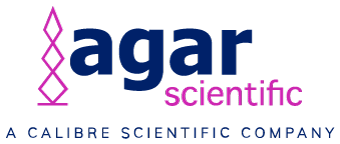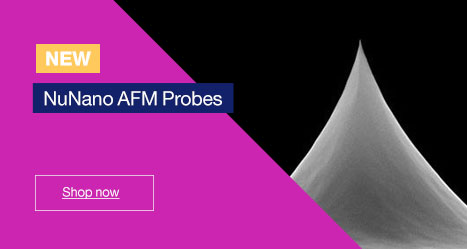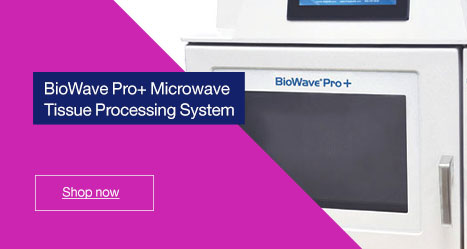Following on from the last blog article which introduced ‘sandwich’ methods, we’ll have an in-depth look at an important histology tool; streptavidin/biotin.
Biotin is also known as Vitamin B7 or Coenzyme R. As well as these three names, it is known by another – Vitamin H. In this case, the ‘H’ stands for the German names ‘Haar und Haut’ (hair and skin). This is due to biotin’s contribution to promoting the health of hair, skin and nails. Avidin is a protein naturally found in egg white and has a high affinity for biotin. Streptavidin on the other hand is synthesised by bacteria from the Streptomyces family. The Streptomyces bacteria secrete this protein as it inhibits other bacteria which may compete for resources in the same habitat. Due to the formation of a large number of hydrogen bonds (and a high shape-affinity) with biotin, streptavidin has a very high-affinity for biotin. These factors have led to streptavidin being favoured over avidin when it comes to using these proteins in biological research applications. In addition, there is less non-specific binding between streptavidin and biotin compared to avidin/biotin.
It was in the 1970’s when the high-affinity of streptavidin/biotin started to be applied to biological research. A research group from the Institut Pastuer published a paper in 1979 describing their work in which they used biotin to label both antigens and antibodies (1). They revealed that this labelling technique could be used for immunohistochemistry (IHC) and for quantitative immunosassays. Then two years later in 1981, a research group working in the Department of Pathology at Brown University, Rhode Island published a paper (2) highlighting a technique which is still widely used to this day; the Avidin-Biotin-Peroxidase Complex (ABC). This method involves the labelling of secondary antibodies with biotin, followed by incubation with the Avidin-Biotin-Peroxidase Complex. The biotin label on the secondary antibodies forms a link between the primary antibody and the ABC.
It was the company Vector Labs who offered one of the first commercially available streptavidin/biotin kits back in 1977. Furthermore, they were also involved in the patenting and development of the ABC system and again offered these as commercial kits. Soon after, many other companies offered their own kits and these are widely available today in a variety of formats. In addition to peroxidase labels, streptavidin and avidin proteins are commercially available which are linked to other ligands including fluorescent labels, offering an even wider range of applications to IHC and many other research problems. For example, the high affinity of avidin/streptavidin and biotin is used in a wide range of techniques such as ELISA and Western Blots.
A single antibody (or protein of interest) can be labelled with many biotin molecules which means this technique can be used to amplify weaker IHC signals. Although the ABC method is very sensitive and has advantages such as signal amplification, it does come with limitations in certain types of tissue. Tissue such as liver and kidney contain endogenous biotin which can obviously lead to high background and false positive results. Moreover, antigen unmasking or retrieval techniques can unmask endogenous biotin in tissue which would otherwise be unavailable. In addition, ABC techniques are particularly suited for formalin fixed tissue as frozen tissue sections tend to have more endogenous biotin present. Finally, the relatively large size of the AB-complex can lead to problems of penetration especially in thicker tissue sections.
To overcome the problems above, there are many commercially available kits which will block endogenous biotin. However, this is a fairly simple procedure if you have biotin and streptavidin/avidin available;
Endogenous biotin blocking
Materials
- Wash buffer (use either Phosphate Buffered Saline (PBS) or Tris Buffered Saline (TBS))
- Biotin (0.01 % in wash buffer)
- Avidin or Streptavidin (0.05 % in wash buffer)
Method
(Carry out this step after blocking with normal serum blocking and before you incubate with your primary antibody)
- Incubate tissue sections with avidin or streptavidin solution for 20 minutes.
- Wash in wash buffer.
- Incubate tissue sections with the biotin solution for 20 minutes.
- Wash in wash buffer.
- Continue with primary antibody incubation.
Step (1) blocks any endogenous biotin and step (3) will then saturate any available biotin binding sites of the free avidin or streptavidin from the first incubation. The third step is needed to block any additional biotin binding sites which may be present after the avidin/streptavidin from step (1) is bound to your tissue section, otherwise this additional avidin/streptavidin may bind the biotin-labelled antibody used in your IHC method.
Your tissue of interest may have no endogenous biotin, therefore I would always recommend doing a ‘test-run’ with control tissue to determine if you need to actually add this step to the IHC method.
Brief peroxidase IHC method for ABC
- Dewax and rehydrate slides. (See my blog post from December 9th 2014 (‘H and E Part Two: Method, Tips and Troubleshooting’))
- Carry out antigen unmasking/retrieval if needed. (See my blog post from December 17th 2014 (‘Unmask Those Antigens: Retrieval Techniques to Enhance Immunohistochemistry’))
- Carrying out blocking using normal serum from the same species as your secondary antibody.
- Perform the biotin blocking above if necessary.
- Incubate sections with primary antibody for the recommended time.
- Wash three times in wash buffer.
- Carry out peroxidase blocking. Sections are incubated for 20 minutes in a solution of 3% H2O2 in PBS.
- Wash three times in wash buffer.
- Incubate sections with the biotinylated secondary antibody (in PBS) for the recommended time (usually a minimum of 30 minutes).
- Wash three times in wash buffer.
- Add the ABC Peroxidase detection solution for 30 minutes. These kits are commercially available, for example, http://www.piercenet.com/product/abc-staining-kits
- Wash three times in wash buffer.
- Incubate your sections in peroxidase substrate DAB (3,3’-diaminobenzidine). Again, this substrate kit is commercially available, for example, http://www.abcam.com/dab-substrate-kit-ab64238.html
- Wash three times in wash buffer.
- Counterstain if desired.
- Dehydrate tissue sections through alcohols and into xylene
- Add coverslips with mounting medium.
- Guesdon, et al., (1979) The Use of Avidin-Biotin Interaction in Immunoenzymatic Techniques. J Histochem Cytochem 27: 1131-1139.
- http://jhc.sagepub.com/content/27/8/1131.abstract
- Hsu et al., (1981) Use of Avidin-Biotin-Peroxidase Complex (ABC) in Immunoperoxidase Techniques. J Histochem Cytochem 29: 577-580.
- http://jhc.sagepub.com/content/29/4/577.long
Author: Martin Wilson


